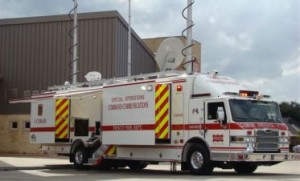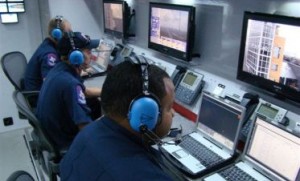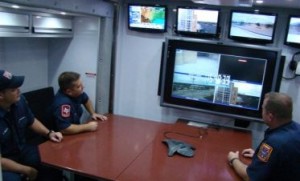A High-Tech EOC on Wheels

The Frisco (Texas) Fire Department's new command and communications truck is used as a mobile emergency operations center.
By Timothy E. Sendelbach
In August 2009, the Frisco (Texas) Fire Department (FFD) took delivery of a new command and communications truck that features high-tech equipment designed to improve incident command and more effectively deploy resources. Using Streambox video technology, the truck is capable of streaming video simultaneously to the Emergency Operations Center (EOC) and other command apparatus. The video provides the EOC with a comprehensive view of unfolding emergencies. Recently, I interviewed Chief Mack Borchardt and Assistant Chief Paul Siebert about the new technology and how it’s improving firefighter safety and communications.
Question: Chiefs, describe the command vehicle and how it came about. How did you create the vision for this remarkable vehicle?
Borchardt: Frisco is a relatively fast-growing suburban community north of Dallas-Fort Worth. We knew that our community was growing and the likelihood of a large-scale incident — and frequency of them — was increasing.
Before we moved into a new central fire station, we didn’t have a formal emergency operations center in Frisco. I had anticipated it would take quite some time for buy-in from our other departments to get the EOC, but we were very pleasantly surprised at how fast it was approved. That was largely due to some sports venues here that require us to manage large numbers of people, so the various agencies could see the benefit of the EOC concept.
That EOC and how we were using it helped us set the goals and objectives for what the command and communications truck would do for us. That’s how the concept evolved. And today, we look at that command and communications truck as basically a mobile EOC. It will do everything that our EOC will do, albeit on a smaller scale.
Question: Chief Siebert, I know you played a critical role in designing and speccing this apparatus. Can you describe the apparatus for those who haven’t seen your vehicle, and tell us some of the technologies that it uses?
Siebert: The vehicle is about 45 feet long, built on a Pierce Velocity chassis, and it has three slide-outs that really open up the floor space inside the vehicle and give us an expanded area that we had a hard time finding in other command vehicles out there. The integration of the electronics — the video, the audio, radio system, the computer network, the phone systems — all those things were done by Frontline Communications in Florida, in cooperation with Pierce.
The technology that’s inside the vehicle is the latest and greatest of each of those general areas. The phone systems that operate inside the vehicle are Cisco IP phones that are able to utilize the capabilities of the Internet access from anywhere in the world to get back to a standard phone system that city personnel, city department directors — whomever may be using the vehicle — are familiar with on a daily basis.
For the interoperability gateway, we’re using a product called RIOS from SyTech. We’ve really been pleased with the way that’s turned out because of the user friendliness of the software program. It really just takes a couple of clicks to get the results that you need.
So the cutting-edge technology that is available out there allows us to make the vehicle more user-friendly. People getting in the truck are comfortable almost immediately. We don’t have to spend lots of time trying to train everyone who may need to use the vehicle in the future. It gives us the ability to put people in who have little and sometimes even no experience in the vehicle and get them up to speed rather quickly so they’re focused on the incident rather than on how to operate the vehicle.

The vehicle is user-friendly and comfortable for both communications and command personnel. Very little extra training is required for personnel to work effectively in the vehicle.
Question: Along those lines, chief, when you’re talking about interoperability, are you talking about the communications functions that give you interoperability?
Siebert: Right, we’re talking about the public safety radio system, as well as the integration to the network phone systems and the ability to be able to communicate in and out of the vehicle using the standard 800-MHz radio, which is what we use here in Frisco. We’re able to talk back out to the majority of the agencies here in the metroplex. And because of the walkup features available on the RIOS system, we have the ability to take that vehicle out of the region and maintain communications with whomever we may need to. The truck has several radios installed, which give us the ability to use the national mutual-aid channels or a variety of different avenues to meet up with anybody who’s out there.
Question: One of the things I’d heard about is the Streambox technology that allows you to broadcast live video feeds back to the EOC. Tell me about that system and how you came about putting that in the command vehicle?
Siebert: The technology is basically IP [Internet protocol]-based video. We’re using your standard cell phone air cards, which give us about 500-KB/second throughput to get the video out of the vehicle and back to the EOC. We use that on three different vehicles currently: the command and communications truck, the hazmat response truck and our special operations squad rescue. And all three of those vehicles are outfitted with these cell air cards and a Streambox encoder, and so that’s taking the video from the cameras on those vehicles.
On the command and communications vehicle, it’s actually taking any input that we want to put into it, so we can send video from multiple cameras or desktop images from planning functions or whatever it is we want to send back to the EOC. Once the video gets back through the Internet to the EOC, the Streambox decoder allows us to view the video up on the screens in the EOC.
Because of the compression technology that’s being used, we’re able to get a pretty good signal without the delays that many people associate with streaming video. Most streaming video has buffering rates that cause the video to be 10, 20, 30 seconds behind the actual event. We’re seeing delays of three to five seconds, which is pretty near real time. We’re also seeing pretty close to full-motion video. You don’t see the chop you see in security cameras or other IP-based streaming videos, so it’s pretty powerful technology.
Borchardt: It also allows us to take our thermal imaging cameras [TICs] and stream that video to the unit on scene and to our EOC. That has immediate value for the folks working inside a building, for us to be able to see that on the outside and compare it to our action plan.
In the EOC, we also have all our traffic cameras feeding video. We have an agreement with a traffic engineering department for them to work out of our EOC. All the intersections are getting pan-tilt zoom cameras on them soon, and all of those images are coming into our EOC as well as into our command truck. We’re seeing all motor-vehicle accidents and things of that nature. We’re able to see it long before the crews get there.
Almost by accident, we saw the power of this technology when we had a fire on top of a four-story office building under construction. The crews at our central station were able to go to the EOC and see that fire from a nearby traffic camera very clearly. They were the second-due alarm, and they were able to assess the situation from a view that wasn’t available to people on the ground. That type of information coming to us has had unanticipated value. They say a picture’s worth a thousand words — that’s really what we’re trying to accomplish, get as many different live pictures from as many different angles and sources to identify what’s going on and eliminate some of the confusion that is experienced in describing it with voice communications.

The new truck uses streaming video to provide situational awareness to responders in near real time.
Question: The video gives you the opportunity to see the incident scene as opposed to the troops on the ground having to verbalize everything that they see. Did the department conduct any specialized training to help commanders fully use the video to support the decision-making process?
Borchardt: It’s a lot of technology, and I think we anticipated it would be difficult to integrate and get everybody trained on it. But we found that it’s user-friendly, it’s very reliable and as a result, we almost got it and started using it at the same time. We’re developing training, but the folks have seemed to adapt very well. We have our special events here that give us an opportunity to use the technology routinely. They’re watching it in the emergency operations center; they’re watching it in the command vehicle. They’re using it as much as they would use their eyes and ears with a portable radio. The difference is they’re able to see it on screen rather than have the explanation via radio.
Question: You’ve also established an agreement with the school districts in regard to the cameras within the schools. Can you describe that agreement and how it came about and what it brings to you?
Borchardt: For years, we’ve had GIS here. And it was always my dream to have GIS-based, pre-incident planning documents available to us on our in-cab computers. I wanted to be able to drill down on a particular building and see water lines and electric lines and gas lines underground — but also be able to see the building as it was built on top of the ground and to attach pre-fire plans. We call them SAFER [situational awareness for emergency responders] plans. But we could never get the piece that had the plans connected to the mapping.
Our school system had looked at a product on the market that would basically be our pre-fire planning for all the schools on a DVD that we could put in our in-cab computers. My concern was that it would be one system for the schools and another system for all the other buildings in Frisco. So we talked to the school system, and they allowed us to work with our city IT department and use the money that they were going to use to purchase this pre-incident software package to develop something more along the lines of my original vision.
They — the city, the Frisco Independent School District along with the Frisco IT department — picked the brains of the fire and police officers to figure out what we needed. We showed them our pre-incident software. The first thing they did was try to purchase it; we went to IT conferences and took our IT department to fire conferences. But we couldn’t find anything that actually matched this idea. So our IT department began the process of developing it, and along the way, they determined that they could give us live camera feeds out the schools, too.
That’s gotten a lot of attention, but the reality, the foundation of it is much more powerful because along with those live camera and still images, we have all of our pre-incident analysis in a system that also includes updates the school district is entering into their documentation — contacts, floor plans, building changes. All of that stuff is changed almost as it happens, which for me far exceeds any pre-incident information we’ve ever had. We’ve gone from trying to carry it in file cabinets, on fire apparatus and in battalion chiefs’ vehicles, to having it available to us instantaneously. The fire officer or police officer going to an incident in the school system can click on that map for that school, see the floor plans and the pre-incident planning information, but you can also click on a hyperlink and access to anywhere from 50 to probably 150 cameras in any school in Frisco.
Siebert: The biggest advantage that I can think of, as an officer, is that we’ve gone from trying to make decisions based on what we remember about a particular building to having detailed information available in the mobile data computer or laptop in the front of the vehicle. We’re putting it so close in front of the officers that it’s intuitive now for them to go to it and look at it. Cameras are a big advantage but even without the cameras, it’s a step forward in the amount of information that we have.
If you imagine Google Maps or Microsoft Live or one of those mapping software programs, but it also includes the water lines, the gas lines, the electric lines, the information about the roadways. And, when you zoom in on one of your buildings, imagine being able to peel the roof off and look at the floor plan on the inside. If you imagine all that, you start to get an idea of what we’re looking at in the front of that apparatus in the three to five minutes that it’s taking us to get to the incident. Hard to describe the leap forward that the technology has given us in making it user-friendly for that officer, so they’re not having to do five different things to get that information. They’re really in one place, getting it all.
Borchardt: Our pilot program was with Frisco Independent School District. We’re now expanding that to every public and commercial/office building in Frisco. So our pre-incident planning is going to be for all of the buildings in Frisco, not just the schools, and it’s moving very quickly.
Question: All this GIS terminology and all this high-tech equipment, to many folks, is still intimidating. What kind of advice would you have for another department trying to make their fireground more reflective of the technology that’s out there? Any tips or lessons that you learned through the course of speccing and using this apparatus?
Siebert: My advice would be, if you have an IT department, get to know them and let them get to know you because they don’t always understand how the fire service is looking at things. They don’t always understand that perspective. But with the group of people we have here in Frisco and our IT department, they were incredibly open to learning our way of doing things and were very, very, very interested in why we did things.
If you don’t have an IT department, look into your staff. For people coming into the fire service today or have been here a few years, technology is something they’ve always been familiar with. The things that intimidate me about technology may not intimidate someone who is younger and has grown up with technology more than I have. I think that generation gap could be a big advantage here.
The concept of the EOC after we had built it became let’s put as much information as possible in front of the people who have to make decisions. When we really took that tact, it opened up the amount of information that we had coming into the room. It changed from “let’s set the truck up so the fire service can use it or the police can use it or the water department can use it” to “let’s set it up so that we’re getting as much information into the truck as possible, and then the truck becomes multifunctional.” From there, we let the technology gurus take over.
About the Author
Timothy E. Sendelbach is editor in chief of FireRescue magazine, published by Elsevier Public Safety.

